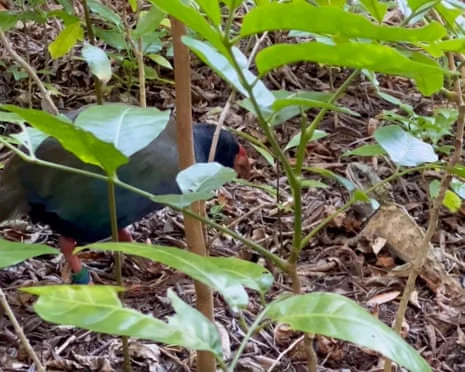
A Rare Encounter: Takahē and Tuatara Clash on Tiritiri Matangi Island
In a remarkable display of New Zealand's unique wildlife, a recent encounter between two endangered species—the takahē and tuatara—has shed light on the dynamic interactions within their ecosystems. Captured on video by Department of Conservation ranger Nick Fisentzidis, this unusual confrontation showcases both species, each emblematic of New Zealand's natural heritage, and raises awareness about the challenges they face.
Set on the idyllic, predator-free Tiritiri Matangi Island, the footage reveals a brief, yet captivating altercation. According to Fisentzidis, he witnessed the rotund, blue takahē seemingly take on the tuatara, a reptile often referred to as a "living fossil." The ranger stated, "I saw them having a bit of a nip at each other; the takahē definitely had a go at the tail of the tuatara, and they had a bit of a scrap." The video shows the vibrant takahē pursuing the tuatara until the tables turned, with the tuatara retaliating before the takahē retreated into the forest.

This incident is notable not only for its entertainment value but also for its implications for conservation. Both the takahē and tuatara were once widespread across New Zealand but have seen their habitats dwindle due to human activity and the introduction of invasive predators. The takahē, thought extinct in 1898 and rediscovered in 1948, has approximately 500 individuals remaining, while tuatara are often found only on predator-free islands.
Fisentzidis reflected on the importance of understanding these interactions, saying, "It’s a neat snapshot of how these interactions may have gone in the past. It also shows what’s possible in the future if we really start to rally together to bring more of our native wildlife back." The exchange highlights the resilience of these species and the ongoing efforts to restore their populations.
Moreover, these insights are echoed by Glen Greaves, the DOC Takahē Recovery Senior Ranger, who explained the omnivorous nature of the takahē, which often supplements its herbivorous diet with insects and even other small creatures. This behavior offers a glimpse into the ecological roles these unique birds play in their habitat.
Tiritiri Matangi Island is celebrated as one of the most successful community-led conservation projects globally, where native wildlife thrives amidst careful stewardship. Open to the public, it's a mere 75-minute ferry ride from downtown Auckland, allowing visitors to engage with New Zealand's rich biodiversity.
As we reflect on this extraordinary pairing, we must consider the broader message of conservation and coexistence. With ongoing efforts to protect these species, how can we, as individuals and communities, contribute to the preservation of New Zealand's unique wildlife? Share your thoughts and experiences in the comments below!